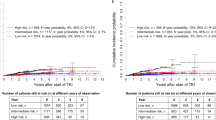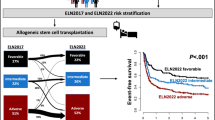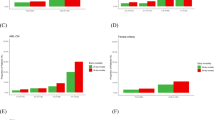Abstract
Patients with secondary acute myeloid leukemia (sAML) are generally thought to have a poor prognosis. As there are no prognostic risk stratification models for patients with sAML available, the aim of this study was to obtain a scoring system. Prognostic factors influencing overall survival (OS) and event-free survival (EFS) were analyzed in 305 sAML patients treated in the prospective AML96 trial. The obtained prognostic scoring system was then validated in an independent patient cohort included in the AML2003 and AML60+ trials. In addition to the known risk factors for AML, age and karyotype, we identified the absolute platelet count and the Nucleophosmin 1 mutational status at diagnosis as prognostic factors of sAML patients. A pronounced distribution of sAML patients into three score groups was achieved showing a 2-year OS/EFS of 52/44% for patients in the low-risk group, 21/12% in the intermediate-risk group and 7/3% in the high-risk group (both P<0.001). Validation of this scoring system in a second independent set of sAML patients revealed similar significantly different survival results. In conclusion, for the first time, a prognostic scoring system is provided for sAML patients, allowing differential treatment strategies in the future.
This is a preview of subscription content, access via your institution
Access options
Subscribe to this journal
Receive 12 print issues and online access
$259.00 per year
only $21.58 per issue
Buy this article
- Purchase on Springer Link
- Instant access to full article PDF
Prices may be subject to local taxes which are calculated during checkout



Similar content being viewed by others
References
Leone G, Mele L, Pulsoni A, Equitani F, Pagano L . The incidence of secondary leukemias. Haematologica 1999; 84: 937–945.
Mufti GJ . Pathobiology, classification, and diagnosis of myelodysplastic syndrome. Best Pract Res Clin Haematol 2004; 17: 543–557.
Leith CP, Kopecky KJ, Godwin J, McConnell T, Slovak ML, Chen IM et al. Acute myeloid leukemia in the elderly: assessment of multidrug resistance (MDR1) and cytogenetics distinguishes biologic subgroups with remarkably distinct responses to standard chemotherapy. A Southwest Oncology Group study. Blood 1997; 89: 3323–3329.
Mauritzson N, Albin M, Rylander L, Billstrom R, Ahlgren T, Mikoczy Z et al. Pooled analysis of clinical and cytogenetic features in treatment-related and de novo adult acute myeloid leukemia and myelodysplastic syndromes based on a consecutive series of 761 patients analyzed 1976–1993 and on 5098 unselected cases reported in the literature 1974–2001. Leukemia 2002; 16: 2366–2378.
Estey E, Dohner H . Acute myeloid leukaemia. Lancet 2006; 368: 1894–1907.
Rund D, Krichevsky S, Bar-Cohen S, Goldschmidt N, Kedmi M, Malik E et al. Therapy-related leukemia: clinical characteristics and analysis of new molecular risk factors in 96 adult patients. Leukemia 2005; 19: 1919–1928.
Wheatley K, Brookes CL, Howman AJ, Goldstone AH, Milligan DW, Prentice AG et al. Prognostic factor analysis of the survival of elderly patients with AML in the MRC AML11 and LRF AML14 trials. Br J Haematol 2009; 145: 598–605.
Schaich M, Soucek S, Thiede C, Ehninger G, Illmer T . MDR1 and MRP1 gene expression are independent predictors for treatment outcome in adult acute myeloid leukaemia. Br J Haematol 2005; 128: 324–332.
Chomczynski P, Sacchi N . Single-step method of RNA isolation by acid guanidinium thiocyanate-phenol-chloroform extraction. Anal Biochem 1987; 162: 156–159.
Thiede C, Steudel C, Mohr B, Schaich M, Schakel U, Platzbecker U et al. Analysis of FLT3-activating mutations in 979 patients with acute myelogenous leukemia: association with FAB subtypes and identification of subgroups with poor prognosis. Blood 2002; 99: 4326–4335.
Thiede C, Koch S, Creutzig E, Steudel C, Illmer T, Schaich M et al. Prevalence and prognostic impact of NPM1 mutations in 1485 adult patients with acute myeloid leukemia (AML). Blood 2006; 107: 4011–4020.
Cheson BD, Bennett JM, Kopecky KJ, Buchner T, Willman CL, Estey EH et al. Revised recommendations of the international working group for diagnosis, standardization of response criteria, treatment outcomes, and reporting standards for therapeutic trials in acute myeloid leukemia. J Clin Oncol 2003; 21: 4642–4649.
Schiffer CA, Anderson KC, Bennett CL, Bernstein S, Elting LS, Goldsmith M et al. Platelet transfusion for patients with cancer: clinical practice guidelines of the American Society of Clinical Oncology. J Clin Oncol 2001; 19: 1519–1538.
Wandt H, Ehninger G, Gallmeier WM . New strategies for prophylactic platelet transfusion in patients with hematologic diseases. Oncologist 2001; 6: 446–450.
Krauter J, Wagner K, Schafer I, Marschalek R, Meyer C, Heil G et al. Prognostic factors in adult patients up to 60 years old with acute myeloid leukemia and translocations of chromosome band 11q23: individual patient data-based meta-analysis of the German Acute Myeloid Leukemia Intergroup. J Clin Oncol 2009; 27: 3000–3006.
Frohling S, Schlenk RF, Kayser S, Morhardt M, Benner A, Dohner K et al. Cytogenetics and age are major determinants of outcome in intensively treated acute myeloid leukemia patients older than 60 years: results from AMLSG trial AML HD98-B. Blood 2006; 108: 3280–3288.
Buchner T, Berdel WE, Haferlach C, Haferlach T, Schnittger S, Muller-Tidow C et al. Age-related risk profile and chemotherapy dose response in acute myeloid leukemia: a study by the German Acute Myeloid Leukemia Cooperative Group. J Clin Oncol 2009; 27: 61–69.
Ferrara F, Criscuolo C, Riccardi C, Izzo T, Pedata M, Copia C et al. FLT3 mutations have no prognostic impact in elderly patients with acute myeloid leukemia and normal karyotype. Am J Hematol 2009; 84: 532–535.
Borowitz MJ, Gockerman JP, Moore JO, Civin CI, Page SO, Robertson J et al. Clinicopathologic and cytogenic features of CD34 (My 10)-positive acute nonlymphocytic leukemia. Am J Clin Pathol 1989; 91: 265–270.
Solary E, Casasnovas RO, Campos L, Bene MC, Faure G, Maingon P et al. Surface markers in adult acute myeloblastic leukemia: correlation of CD19+, CD34+ and CD14+/DR--phenotypes with shorter survival. Groupe d′Etude Immunologique des Leucemies (GEIL). Leukemia 1992; 6: 393–399.
Grimwade D, Walker H, Harrison G, Oliver F, Chatters S, Harrison CJ et al. The predictive value of hierarchical cytogenetic classification in older adults with acute myeloid leukemia (AML): analysis of 1065 patients entered into the United Kingdom Medical Research Council AML11 trial. Blood 2001; 98: 1312–1320.
Schlenk RF, Dohner K, Kneba M, Gotze K, Hartmann F, Del Valle F et al. Gene mutations and response to treatment with all-trans retinoic acid in elderly patients with acute myeloid leukemia. Results from the AMLSG Trial AML HD98B. Haematologica 2009; 94: 54–60.
Greenberg P, Cox C, LeBeau MM, Fenaux P, Morel P, Sanz G et al. International scoring system for evaluating prognosis in myelodysplastic syndromes. Blood 1997; 89: 2079–2088.
Germing U, Platzbecker U, Giagounidis A, Aul C . Platelet morphology, platelet mass, platelet count and prognosis in patients with myelodysplastic syndromes. Br J Haematol 2007; 138: 399–400.
Kao JM, McMillan A, Greenberg P . International MDS risk analysis workshop (IMRAW)/IPSS reanalyzed: impact of cytopenias on clinical outcomes in myelodysplastic syndromes. Am J Hematol 2008; 83: 765–770.
Pagano L, Pulsoni A, Vignetti M, Tosti ME, Falcucci P, Fazi P et al. Secondary acute myeloid leukaemia: results of conventional treatments. Experience of GIMEMA trials. Ann Oncol 2005; 16: 228–233.
Pulsoni A, Pagano L, Latagliata R, Casini M, Cerri R, Crugnola M et al. Survival of elderly patients with acute myeloid leukemia. Haematologica 2004; 89: 296–302.
Ferrara F, Fazi P, Venditti A, Pagano L, Amadori S, Mandelli F . Heterogeneity in the therapeutic approach to relapsed elderly patients with acute myeloid leukaemia: a survey from the Gruppo Italiano Malattie Ematologiche dell′ Adulto (GIMEMA) Acute Leukaemia Working Party. Haematol Oncol 2008; 26: 104–107.
Falini B, Mecucci C, Tiacci E, Alcalay M, Rosati R, Pasqualucci L et al. Cytoplasmic nucleophosmin in acute myelogenous leukemia with a normal karyotype. N Engl J Med 2005; 352: 254–266.
Andersen MT, Andersen MK, Christiansen DH, Pedersen-Bjergaard J . NPM1 mutations in therapy-related acute myeloid leukemia with uncharacteristic features. Leukemia 2008; 22: 951–955.
Lo-Coco F, Cuneo A, Pane F, Cilloni D, Diverio D, Mancini M et al. Prognostic impact of genetic characterization in the GIMEMA LAM99P multicenter study for newly diagnosed acute myeloid leukemia. Haematologica 2008; 93: 1017–1024.
Pedersen-Bjergaard J, Andersen MK, Andersen MT, Christiansen DH . Genetics of therapy-related myelodysplasia and acute myeloid leukemia. Leukemia 2008; 22: 240–248.
Falini B . Therapy-related acute myeloid leukaemia with mutated NPM1: treatment induced or de novo in origin? Leukemia 2008; 22: 891–892.
Falini B, Nicoletti I, Martelli MF, Mecucci C . Acute myeloid leukemia carrying cytoplasmic/mutated nucleophosmin (NPMc+ AML): biologic and clinical features. Blood 2007; 109: 874–885.
Dohner K, Schlenk RF, Habdank M, Scholl C, Rucker FG, Corbacioglu A et al. Mutant nucleophosmin (NPM1) predicts favorable prognosis in younger adults with acute myeloid leukemia and normal cytogenetics: interaction with other gene mutations. Blood 2005; 106: 3740–3746.
Falini B, Bolli N, Liso A, Martelli MP, Mannucci R, Pileri S et al. Altered nucleophosmin transport in acute myeloid leukaemia with mutated NPM1: molecular basis and clinical implications. Leukemia 2009; 23: 1731–1743.
Scholl S, Theuer C, Scheble V, Kunert C, Heller A, Mugge LO et al. Clinical impact of nucleophosmin mutations and Flt3 internal tandem duplications in patients older than 60 yr with acute myeloid leukaemia. Eur J Haematol 2008; 80: 208–215.
Löwenberg B . Acute myeloid leukemia: the challenge of capturing disease variety. Am Soc Hematol Educ Program 2008; 1: 1–11.
Acknowledgements
The contribution of all the patients and physicians in the various trials of the German Study Alliance Leukemia (SAL) is highly appreciated. Supported in part by a grant from the ‘Deutsche Krebshilfe e.V.’, Bonn, Germany, Grant No. 70-2210-Eh5.
Author information
Authors and Affiliations
Consortia
Corresponding author
Ethics declarations
Competing interests
The authors declare no conflict of interest.
Additional information
This study has been presented in part at the 51st Annual Meeting of the American Society of Hematology, 5–8 December 2009, New Orleans, Louisiana, USA.
Supplementary Information accompanies the paper on the Leukemia website
Appendix
Appendix
List of participating centers and physicians of the Study Alliance Leukemia (SAL)
D Huhn and O Knigge (Universitätsklinikum Charité, Campus Virchow, Berlin); E Spaeth-Schwalbe and S Hesse-Amojo (Krankenhaus Spandau, Berlin); O Rick and W Siegert (Charité Campus Mitte, Berlin); E Thiel and L Uharek (Universitätsklinikum Charité, Campus Benjamin-Franklin, Berlin); R Kolloch and U Krümpelmann (Krankenanstalten Gilead, Bielefeld); K-H Pflueger and T Wolff (Evang Diakonissenanstalt Bremen); H-H Heidtmann (St Joseph-Hospital, Bremerhaven); F Marquard (Allgemeines Krankenhaus, Celle); M Hänel, F Fiedler and R Herbst (Krankenhaus Küchwald, Chemnitz); M Gramatzki and G Helm (Universitätsklinikum, Erlangen); J-G Saal (Malteser Krankenhaus, Flensburg); H-G Hoeffkes and M Arland (Städtisches Klinikum, Fulda); E Fasshauer (St Elisabeth-Krankenhaus, Halle); R Stuhlmann (Asklepios Krankenhaus St Georg, Hamburg); H Schmidt and K Buhrmann (Kreiskrankenhaus, Hameln); H Duerk (St Marien-Hospital, Hamm); M Burk (Klinikum Stadt, Hanau); A-D Ho and U Mahlknecht (Universitätsklinikum, Heidelberg); A Bartholomaeus (St Bernward Krankenhaus, Hildesheim); AA Fauser (Klinik f Hämatologie/Onkologie und KMT, Idar-Oberstein); H Link and F-G Hagmann (Westpfalzklinikum, Kaiserslautern); G Koechling (Kreiskrankenhaus, Leer); K-P Schalk (St Vincent-Krankenhaus, Limburg/Lahn); S Fetscher (Städtisches Krankenhaus Süd, Lübeck); T Wagner (Universitätsklinikum, Lübeck); A Neubauer (Universitätsklinikum, Marburg); J Tischler (Klinikum Minden, Minden); H Pohlmann and N Brack (Städtisches Krankenhaus München Harlaching, München); M Wilhelm, H Wandt and K Schaefer-Eckart, (Städtisches Klinikum, Nürnberg); B Seeber (Klinikum Offenbach, Offenbach); F Hirsch (Kreiskrankenhaus Offenburg, Offenburg); T Geer and H Heissmeyer (Diakonie-Krankenhaus, Schwäbisch-Hall); J Labenz (Ev Jung-Stilling-Krankenhaus, Siegen); J Kaesberger (Diakonissen-Krankenhaus, Stuttgart); L Leimer (Robert-Bosch-Krankenhaus, Stuttgart); MR Clemens and R Mahlberg (Klinikum Mutterhaus der Borromäerinnen, Trier); R Schwerdtfeger (Deutsche Klinik für Diagnostik, Wiesbaden); R Engberding and R Winter (Stadtkrankenhaus, Wolfsburg); M Sandmann (Klinikum St Antonius, Wuppertal); H Einsele, F Weissinger and H Rueckle-Lanz (Universitätsklinikum, Würzburg).
Rights and permissions
About this article
Cite this article
Stölzel, F., Pfirrmann, M., Aulitzky, W. et al. Risk stratification using a new prognostic score for patients with secondary acute myeloid leukemia: results of the prospective AML96 trial. Leukemia 25, 420–428 (2011). https://doi.org/10.1038/leu.2010.279
Received:
Revised:
Accepted:
Published:
Issue Date:
DOI: https://doi.org/10.1038/leu.2010.279
Keywords
This article is cited by
-
Measurable residual disease (MRD) status before allogeneic hematopoietic cell transplantation impact on secondary acute myeloid leukemia outcome. A Study from the Acute Leukemia Working Party (ALWP) of the European society for Blood and Marrow Transplantation (EBMT)
Bone Marrow Transplantation (2022)
-
Comprehensive prognostic scoring systems could improve the prognosis of adult acute myeloid leukemia patients
International Journal of Hematology (2019)
-
p53 pathway dysfunction is highly prevalent in acute myeloid leukemia independent of TP53 mutational status
Leukemia (2017)
-
Karyotype complexity and prognosis in acute myeloid leukemia
Blood Cancer Journal (2016)
-
Impact of the revised International Prognostic Scoring System on the outcome of patients with acute myeloid leukemia with or without antecedent myelodysplastic syndrome
Leukemia (2014)



